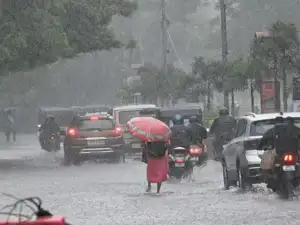Photo Courtesy: Google
The India Meteorological Department (IMD) has confirmed that the southwest monsoon has now covered most parts of North India and is likely to reach Punjab, Haryana, and Delhi within the next two days. This early and accelerated movement of the monsoon is being closely watched due to its significant impact on agriculture, city infrastructure, and daily life across the northern belt.
Early Monsoon Surge Across North India
According to IMD updates, the monsoon has already advanced into key parts of Jammu and Kashmir, Ladakh, Himachal Pradesh, and parts of Punjab. The strong cyclonic circulation over Uttar Pradesh and the extension of a trough line from Punjab to Bihar have created favourable conditions for the monsoon to surge further. Meteorologists now expect the monsoon to arrive in Delhi, Haryana, and remaining parts of Punjab by June 24—nearly three to four days ahead of its normal onset date.
This early arrival is not only a relief from the sweltering heat but also signals a strong start to the kharif crop season. The early monsoon is also expected to bring a change in the prevailing wind patterns and humidity levels across North India.
Heavy Rainfall Alerts in Punjab, Haryana, and Delhi
The IMD has issued yellow and orange alerts for heavy to very heavy rainfall in Punjab and Haryana over the next 48 to 72 hours. Delhi, too, is under a yellow alert, with thunderstorms and gusty winds expected as the monsoon arrives. The northern plains, including cities like Chandigarh, Ludhiana, Amritsar, Gurugram, and Noida, are likely to receive widespread rainfall accompanied by lightning and wind speeds ranging from 40 to 50 km/h.
These rains will likely provide much-needed relief from ongoing heatwaves in northern cities, where temperatures have remained above 40°C for several consecutive days. However, the IMD has warned of possible waterlogging, traffic disruption, and localised flooding in urban areas.
Agricultural Implications of Early Monsoon Onset
The early onset of monsoon over Punjab and Haryana is being welcomed by the farming community. Farmers across the region had already begun land preparation and early sowing in anticipation of timely rains. The arrival of the southwest monsoon is expected to enhance soil moisture levels and boost the sowing of paddy, cotton, maize, and pulses.
However, agriculture experts caution that heavy downpours in short spells may also lead to erosion and water stagnation, which could damage young crops. As a result, farmers are being advised to monitor field drainage and avoid excessive early fertiliser application.
Urban Preparedness and Weather Impact
Urban centres like Delhi and Chandigarh are now preparing for the onset of rain with emergency services on alert. Municipal corporations and drainage departments have begun clearing clogged drains and deploying rapid response units to mitigate any disruptions caused by the first spell of heavy showers.
Delhi, which often experiences waterlogging in key locations during early monsoon, is expected to see improved air quality due to rain. However, increased humidity levels may lead to a temporary spike in health complaints like respiratory discomfort and water-borne infections.
Climatic Trends and Monsoon Behaviour
This year, the monsoon arrived over Kerala on May 30, two days ahead of schedule. After a brief slowdown in its progress, the monsoon picked up pace again in mid-June, covering Central India and parts of the northwest in a span of less than a week. Meteorologists attribute this swift progress to favourable wind patterns, low-pressure systems in the Bay of Bengal, and supportive oceanic conditions in the Arabian Sea.
The IMD’s long-range forecast continues to predict normal to above-normal rainfall for most parts of northwest India, including Punjab, Haryana, and Delhi. If consistent, this trend could help mitigate the effects of groundwater depletion and provide a better reservoir recharge in the region.
A Season of Opportunities and Risks
As the southwest monsoon covers more parts of North India, the next few days will be crucial for both rural and urban populations. While it brings respite from the oppressive heat, it also demands preparedness to face the challenges of intense rainfall. From agriculture to infrastructure, the early arrival of monsoon this year is poised to impact every aspect of life across Punjab, Haryana, and Delhi.




